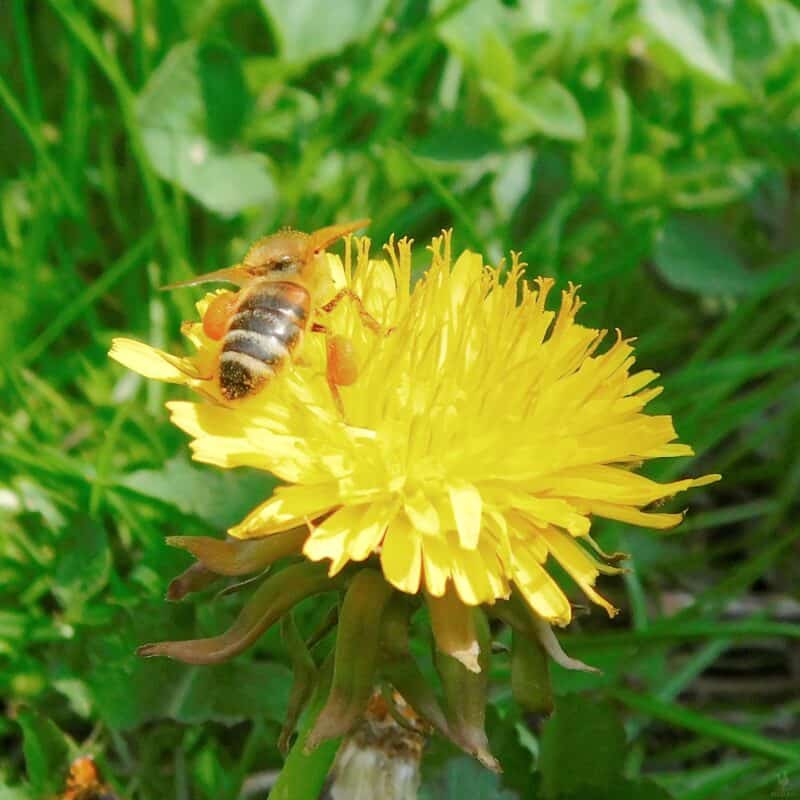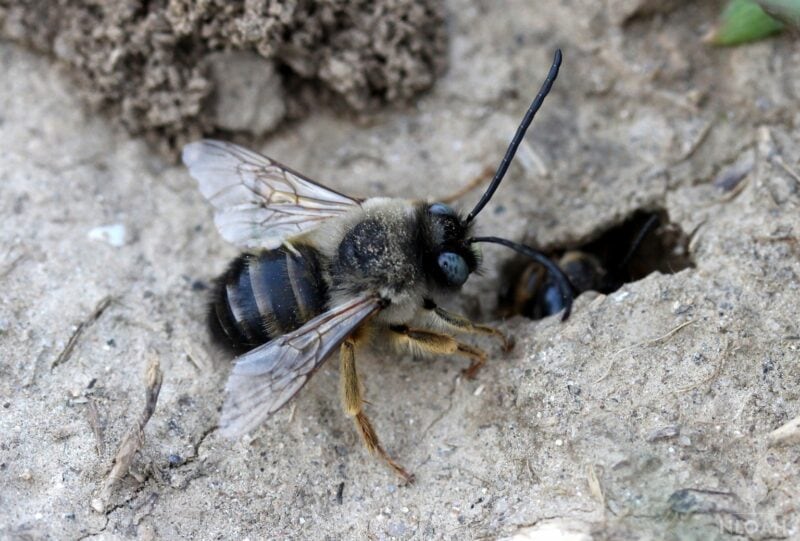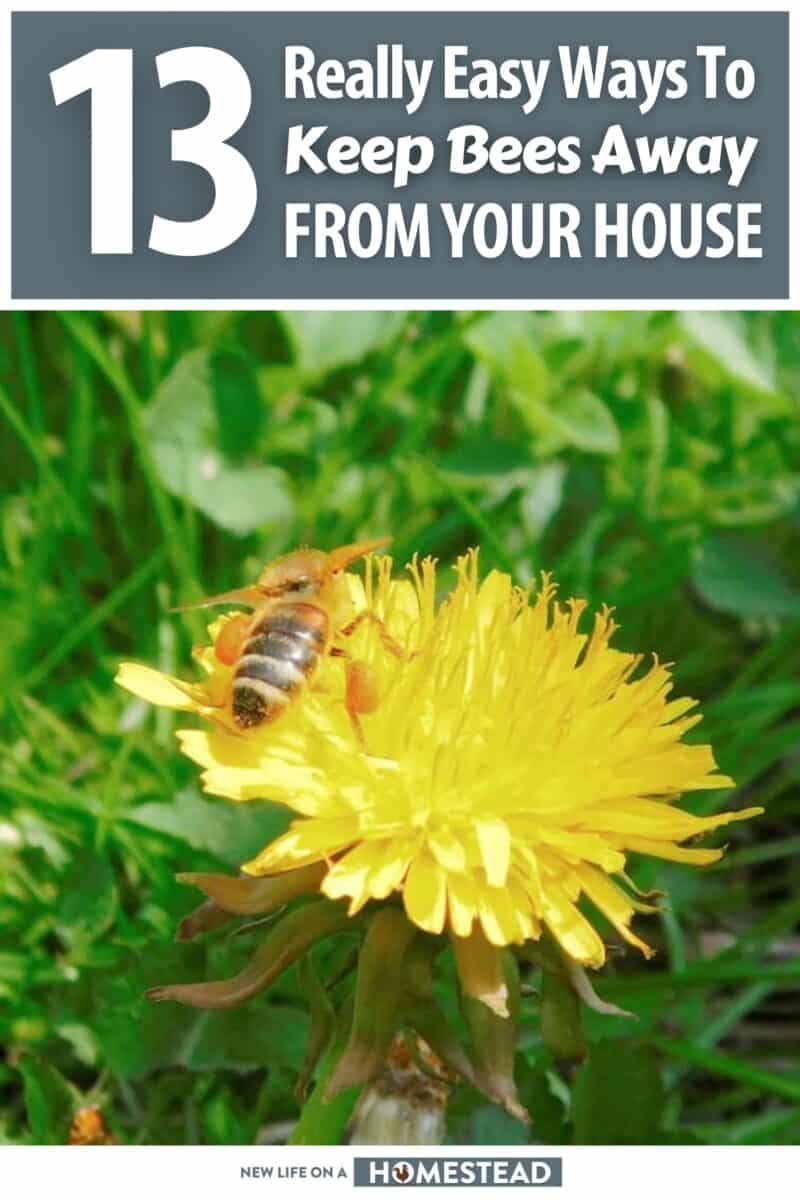Pretty much everyone knows by now that bees are among the most important creatures in nature, even though they are some of the tiniest.

These are some of the most important pollinators found the world over, and without them, so many of the crops we depend on would basically disappear.
But bees, as it turns out, pack quite a wallop with those stingers, and if bees have set up shop too close to your house or, worse, nested inside of it, it’s only a matter of time until you get lit up.
But if we can, we want to avoid killing the bees because they need all the help they can get. It’s best to just keep them away from your house instead.
Keep reading and I’ll give you 13 foolproof and easy methods for doing just that.
Table of Contents:
1. Get Rid of Ground Clutter
The very first thing you should do around your property, and one of the best ways to help keep bees at bay, is to just tidy up your grounds.
Bees are attracted to areas that have lots of natural ground clutter, because these tend to be good places to find nests and also to find food.
So if you have lots of leaves, old or dead growth, grass clippings, and lots of other natural ground cover on your property, it’s time to bust out the rake and wheelbarrow and take care of it.
Getting rid of all this clutter will first reduce the attractiveness of your property to bees in the first place, and it also makes your job of locating a new or thriving hive a whole lot easier if it comes down to it.
Just be careful, because some bees and other “colonial” stinging insects tend to nest in the ground and that can be an unpleasant surprise!
2. Dispose of All Junk
The next thing you should do after raking and sweeping up all the clutter covering up your lawn and the rest of your property is to get rid of all the junk lying around that doesn’t serve a purpose.
This could be anything from old children’s toys and playground equipment to discarded luggage, appliances, and absolutely anything else you can think of, but particularly things that are enclosed or hollow.
This is because of bees are attracted to places where they will stay dry and where they won’t be disturbed.
You can do a quick search on YouTube for professional bee removal channels and you’ll see countless cases of beekeepers and, sometimes, brave homeowners trying to eliminate huge beehives that have formed inside the most inconspicuous things.
Old luggage, tires, broken down cars, anything!
Many of these man-made things are actually far more suitable for bees to build in than natural structures like trees, so they’ve got to go.
3. Keep Bee-Attracting Flowers Away from Your House
By far one of the most emotionally painful steps you might have to take if you want to keep bees away is moving flowers away from your home.
I know it sounds elementary, because bees are attracted to flowers, duh, but you may be surprised how many people overlook this critical step.
One of my neighbors a long time ago, a sweet old lady named Gladys, was quite the green thumb and loved nothing more than tending to the flowers she had planted very literally all around her entire house.
Unfortunately, she had lots of flowers that bees absolutely loved, including daisies, pansies, phlox, nasturtiums, and more.
So she was constantly being “terrorized” by bees and was at her wit’s end!
I managed to stop her from calling in the exterminator, and convinced her to take her favorite flowers further away from the house and plant less bee-appealing flowers in her landscaping.
In the end, the bees weren’t wiped out and she didn’t have to put up with their visits as much. You should do the same if you have flowers planted right next to your house!
4. Plant Repellent Herbs Instead
Speaking of planting strategically, you might consider planting bee-repelling plants as companions to your other plants if you want bees to stay away.
There are many herbs and even some flowers that can help you do this. Even if you’re in your garden and dealing with bees, you got options.
Believe it or not, these are repulsed by cucumbers, basil, garlic, marigolds, mint, eucalyptus, geranium, and cinnamon.
Live, dried, or extracted as a tincture or essential oil these flowers and plants have all-natural, bee-safe ingredients that can help keep the little buzzers at bay.
This is an especially good idea if you don’t want to hurt the bees, and you really don’t, and you also don’t want to resort to simply eliminating various flowering plants from your property.
It might take a little bit of homework to find out which companion plantings are best, or which be repellent plants look the nicest, but it’s well worth it.
5. Water Your Lawn and Plants Heavily
One of my favorite techniques for telling bees to take a hike is also one of the simplest and the most relaxing, and it is also a chore that you’re probably already doing anyway.
If you can afford to, simply water your lawn and all of the other plants on your property heavily on a regular basis assuming it won’t hurt them.
This is because bees naturally try to stay away from surfaces that are soaked, and more importantly, they never like to nest in damp or wet areas.
Beehives are always entirely dry and warm, and if bees can’t get protection from rain or persistent moisture, they’ll take their chances somewhere else.
This is an especially good technique for preventing ground bees from setting up shop along with other subterranean stinging insects.
You don’t even necessarily have to try and flood an existing nest; if you do this regularly, bees won’t think twice before passing your property by.
6. Close Off All Nesting Points On and Around Property
Now that you’ve taken reasonable steps to encourage these to ignore nesting on or near your property, it is time to start assessing your home directly.
Grab yourself some metal hardware mesh, a caulking gun with all-weather caulk and some of that canned expanding foam. Start closing up every hole, crack, crevice, and opening on the outside of your home, and especially anything that could potentially let bees get into your soffits or into your walls.
It rarely fails that bees, especially in urban and suburban areas, will look for and find a safe, cozy refuge directly in your home if they get an opportunity.
And it makes sense because they’ll have total protection from predators and weather in there. Obviously, this might result in getting inside your living space, but it can also start damaging your home.
Bees poop and pee, and this moisture can cause mold problems, not to mention what the construction of a hive will do to your drywall and other materials.
Close everything up tight, and pay special attention to chimneys.
7. Avoid Floral Patterns and Bright Colors Around the House
If you have any patio furniture or other decor or furnishings on a deck, patio, gazebo, or under a pergola, as much as it might hurt you, try to avoid floral patterns and bright colors.
As you probably already guessed, this will in fact attract bees. Why do you think bees find certain flowers so attractive in the first place!?
It’s because they look like flowers both in shape and color!
Consider that bees don’t have particularly great eyesight, and it’s entirely possible they could get a false positive on your pretty floral cushions or umbrella from some distance away.
Of course, the bees won’t find anything to eat or carry home when they get there, but bees will continually show up to investigate all the same.
From there, they might hang around looking for other prospects…
8. Hang and Place Mothballs
Despite all these efforts, if bees just keep cruising around or over your property and getting too close to your home, it’s time to step things up a notch.
You can bust out some mothballs and hang them up strategically near your home and elsewhere on your property placed inside an old sock or pantyhose.
These things drive insects crazy and will keep them away and they definitely work on bees.
However, they don’t last nearly as long as they would if they were placed inside your home, so you’ll have to be committed to replacing them regularly.
But aside from this aggravation, they are generally safe for bees and safe for you and your family so they are a great option.
9. Use Deterrents
There are also some specific bee deterrent solutions on the market that you might try if mothballs just aren’t getting it done.
These are usually easy to apply, safe for a variety of surfaces, and also safe for the bees. They don’t hurt them, they just aggravate them and drive them away.
Whatever you buy, be doubly sure you’re getting a deterrent only and not a pesticide that will kill them or other insects.
Also, remember all of those repellent plants we talked about above? Lots of folks have reported great success buying concentrated essential oils from those plants, particularly cinnamon, garlic, and basil essential oils.
None of them smell too offensive and are easy to place anywhere around your home.
Again, you might have to reapply fairly frequently but these are great all-natural solutions that can achieve the same ends.
10. Dust Problem Spots with Baby Powder
Believe it or not, bees seem to have a strong aversion to baby powder. I guess it gets kicked up and stuck to those little baskets on their legs like pollen does, and boy do they not like it!
I heard about this a long time ago and dismissed it as an old wives’ tale and total nonsense. Turns out, those old timers really do know a few things!
All you need is common baby powder, and then sprinkle it liberally in any areas where you see bees visiting or coming and going.
When they land or even fly too close to the surface with the baby powder on it, it will kick it up and then bother them.
When this happens enough, they will quit coming around, believe me. And you won’t really have to do anything afterward because the rain will wash away the baby powder. As expected, reapply periodically.
11. Smoke ‘em Out!
You ever seen those little cans that beekeepers use to smoke their beehives?
As it turns out, this smoke actually keeps the bees calm by disrupting the pheromone signals that organize and direct the hive. If they never get the call to “alarm,” they stay pretty chill.
You can use this technique in a different way to interfere with bees that just won’t leave, and it’s an especially good option if you suspect you have a hive somewhere nearby.
All you need to do is build a fire in your smoke pit, or perhaps use a small portable burn barrel, and place it so that the wind will carry the smoke in the direction of the bees.
In time, this will confuse and agitate them and they will usually stop coming around to avoid exposure.
12. Call a Beekeeper
Folks, there is no shame in calling in a ringer if you’re already in over your head.
If you suspect you have a well-established hive on your property, or no matter what you try bees just keep showing up around your house and hassling you, your family or your pets, call a beekeeper.
Note I said beekeeper, not exterminator. A beekeeper will be more than happy to show up and locate the hive, removing it safely without harming the bees, and transplanting it into a new hive box back on their bee farm.
Most beekeepers are more than eager to do this for free or for a very nominal cost.
It’s a win-win for both of you: you’ll have your bee problem taken care of and the beekeeper will get a brand new hive that they can put to work.

13. How Can You Get Rid of Ground Bees?
Dealing with an unwanted beehive is one thing when it is above ground or in and out of the way place, but dealing with ground bees is another.
An underground beehive can be very difficult to shift using any of the above methods.
Your best bet is to call a professional beekeeper, but if you are determined to do it yourself once you’ve located the hive, go out well after nightfall when all the bees should be inside and calm.
Cover the opening with a tarp and then weigh down the edges to trap the bees inside. Leave it this way for a couple of days and then carefully remove it again at night.
With a little luck, this will stress the bees out enough that they will mass evacuate and relocate their hive.

Tom has lived and worked on farms and homesteads from the Carolinas to Kentucky and beyond. He is passionate about helping people prepare for tough times by embracing lifestyles of self-sufficiency.
